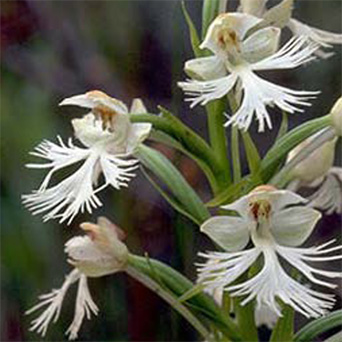Eastern Prairie Fringed-orchid

Species description
Eastern Prairie Fringed-orchid (Platanthera leucophaea) is a rare perennial plant that grows to about 50-100 centimetres in height and displays fringed, white flowers. These flowers have a distinctive ‘lip’ that serves as a landing platform for pollinating insects. Each flower has a very deep ‘nectar spur’ that contains a large quantity of nectar, into which only large insects with long probosci (mouthparts) can reach.
In Canada, 30 occurrences of Eastern Prairie Fringed-orchid have been reported, all in southern and eastern Ontario. The availability of suitable habitat for Eastern Prairie Fringedorchid is limited due to its specific habitat needs. The species requires open sites such as fens, moist old fields and tallgrass prairies that provide full sunlight, moist soils and very limited woody vegetation. A map of the provincial distribution of Eastern Prairie Fringed-orchid is available on the Government of Ontario’s species at risk website.
Eastern Prairie Fringed-orchid faces several threats to its survival and recovery. These threats include habitat loss, suppression of natural fire regimes (which help to maintain required habitat conditions for the species), invasive species (which outcompete and displace many native species, including Eastern Prairie Fringed-orchid) and hybridization with other similar species of orchid. In some areas, plants also face trampling or being run over by recreational vehicles.
The survival and recovery of Eastern Prairie Fringed-orchid is influenced by other factors as well. Because this orchid does not begin reproducing (flowering) until 3-7 years of age, any individual plant that dies before then is unable to contribute to the survival of its population. Individual orchids may also lie dormant for many years between flowerings. This makes it critical to ensure that surveys are repeated over several years to confirm the presence or absence of orchids at a particular site, as the species is much less visible during its dormant stage.
Eastern Prairie Fringed-orchid is listed as endangered at both the provincial (Species at Risk in Ontario List) and federal (Schedule 1 under the Species at Risk Act) levels. Globally, it is considered to be imperiled.
Provincial status
Prior to the Endangered Species Act, 2007 (ESA or “the Act”) the Committee on the Status of Species at Risk in Ontario (COSSARO) assessed Eastern Prairie Fringed-orchid as endangered. It was listed on the Species at Risk in Ontario list as endangered in 2004, but was not regulated under the previous Endangered Species Act. The species retained its endangered status when the ESA came into force in 2008. In future assessments, COSSARO may consider information regarding the species’ threats and trends in population and distribution gained through protection and recovery actions.
Species and habitat protection
As an endangered species, all Eastern Prairie Fringed-orchids have been protected from being killed, harmed, harassed, captured or taken since the ESA came into force in 2008.
In addition, the habitat of Eastern Prairie Fringed-orchid has been protected from being damaged or destroyed since 2010, when the government developed a habitat regulation for the species.
Protecting Eastern Prairie Fringed-orchid and enforcing the regulation protecting the specific habitat of the species are key components in the implementation of the ESA and continue to be government-led actions, as identified in the government response statement. As an endangered species, Eastern Prairie Fringed-orchid has been protected from being killed, harmed, harassed, captured or taken since the ESA came into force in 2008. In addition, the habitat of Eastern Prairie Fringed-orchid has been protected from being damaged or destroyed since 2010, when the government developed a habitat regulation for the species. Prior to its transition to the ESA, there was no species or habitat protection for Eastern Prairie Fringed-orchid. Further information on species and habitat protection is provided in section 2.3 of the introductory chapter of this document.
Although the ESA does not require a habitat regulation to be developed for transition
Any person who negatively impacts Eastern Prairie Fringed-orchid or its habitat without prior authorization may be prosecuted under the ESA.
Recovery strategy
A recovery strategy for Eastern Prairie Fringed-orchid was completed on February 18, 2010, which was in advance of the date required by the ESA. It represents best science advice to government. The strategy identified Eastern Prairie Fringed-orchid’s habitat needs and the threats that it faces, while recommending objectives and approaches for protecting and recovering the species. The recovery strategy also included recommendations on the areas of habitat to be considered in the development of a habitat regulation.
Government response statement
The Ministry of Natural Resources and Forestry (“the Ministry”) published the government response statement (GRS) for Eastern Prairie Fringed-orchid on November 18, 2010, which was within the timeframe required by the ESA. The GRS is government policy that contains the Government of Ontario’s goal for the recovery of Eastern Prairie Fringed-orchid.
Recovery goal
The government's goal for the recovery of Eastern Flowering Dogwood is to protect and conserve existing populations, reduce its rate of decline, and where possible, restore populations of the species across its range in southern Ontario.
To help achieve this goal, the government leads and supports a number of recovery actions. Common actions for the government to lead as it works towards achieving a species’ recovery goal are provided in section 2.5 of the introductory chapter of this document. The GRS for Eastern Prairie Fringed-orchid also outlines six actions for which the Ministry is using a variety of methods to support others to undertake. These government-supported actions fall under the three objectives identified in the GRS, which are:
- Protect Eastern Prairie Fringed-orchid populations, habitat and habitat functionality at all existing locations by reducing or eliminating threats;
- Determine the distribution, abundance and associated trends of Eastern Prairie Fringed-orchid and its habitat; and
- Address knowledge gaps and determine the feasibility of restoration.
The subsequent sections of this chapter provide a review of actions that the government has led or supported to help achieve the recovery goal for Eastern Prairie Fringed-orchid.
Government funded projects
An important government-led action in the GRS for Eastern Prairie Fringed-orchid is to support partners to undertake activities to protect and recover the species. Through the Species at Risk Stewardship Fund the Ministry has supported a total of 26 projects designed to contribute to the protection and recovery of Eastern Prairie Fringed-orchid. Four of these projects ($77,004) focused exclusively on the species, while the other 22 projects ($560,816) focused on multiple species at risk, including Eastern Prairie Fringed-orchid. In addition to the funding provided through the Species at Risk Stewardship Fund, partners focusing exclusively on Eastern Prairie Fringed-orchid reported that they were successful in securing additional funding and in-kind support ($183,760) from other sources, as did partners with projects designed to benefit multiple species at risk, including Eastern Prairie Fringed-orchid ($835,242). These values for additional funding and in-kind support include the estimated value of the time and expertise provided by volunteers, which are outlined below.
Stewardship partners reported that the province’s funding support helped them to involve 15 individuals who volunteered 397 hours of their time toward protection and recovery activities that focused exclusively on Eastern Prairie Fringed-orchid, which has an estimated value of $19,860. As well, a total of 345 individuals volunteered 4,628 hours of their time toward protection and recovery activities for multiple species at risk, including Eastern Prairie Fringed-orchid, which has an estimated value of $147,630.
The Ministry’s stewardship partners also reported that through both their efforts and the efforts of their volunteers to implement actions contained in the GRS, they were successful in enhancing 177 hectares of habitat that will benefit multiple species at risk, including Eastern Prairie Fringed-orchid. In addition, stewardship partners reported providing focused outreach on Eastern Prairie Fringed-orchid to 500 individuals, and ecosystem-based outreach on multiple species (including Eastern Prairie Fringed-orchid) to 2,416 individuals.
The remainder of this section highlights three projects that were supported through the Species at Risk Stewardship Fund and their corresponding governmentsupported recovery actions.
Species at Risk Stewardship Fund
-
 $77,004
$77,004for Eastern Prairie Fringed-orchid exclusively
-
 $560,816
$560,816for multi-species projects that included Eastern Prairie Fringed-orchid
-
 $1,019,002
$1,019,002in additional funding and in-kind support
-
 26
26projects
-
 360
360volunteers
-
 5,025
5,025hours
-
 2,916
2,916people received outreach
-
 177
177hectares of habitat enhanced
One stewardship partner conducted a project over six years to improve populations and the habitat of Eastern Prairie Fringed-orchid in southwestern Ontario. On a yearly basis, the partner used prescribed burns and invasive species management techniques to enhance tallgrass prairie habitat in areas where the species is known to occur. After implementing these actions, the partner’s evaluation efforts indicated that Eastern Prairie Fringed-orchid was growing at sites where it had not previously been found, and the number of flowering (reproducing) orchids generally increased from year to year. In addition, the prevalence of invasive species, one of the primary threats to the survival and recovery of Eastern Prairie Fringed-orchid, has decreased in these areas. This project supported the GRS action to develop and implement management actions to improve the populations and habitat of Eastern Prairie Fringed-orchid.
Another stewardship partner surveyed areas that are considered to be suitable habitat for the species. The partner used the results of a habitat suitability modelling exercise to identify areas that could potentially be occupied by the species. With the help of volunteers that the partner had trained in species identification and survey methods, Eastern Prairie Fringed-orchid was discovered at two of the three areas surveyed. These new records were submitted to the Natural Heritage Information Centre to inform the Ministry’s work to protect and recover Eastern Prairie Fringed-orchid in Ontario. This project aligned with the GRS action that focuses on conducting surveys to locate new populations of Eastern Prairie Fringed-orchid.
In a different project, a partner conducted research in order to determine the degree of genetic variation among six Ontario populations of Eastern Prairie Fringed-orchid. In this project, the stewardship partner assessed the genetic variation within and among several populations of the species, as well as the extent of hybridization between Eastern Prairie Fringed-orchid and a related orchid species at sites where they co-occur. The partner found relatively low genetic diversity and high inbreeding in the surveyed populations, as well as evidence of hybridization with a related species of orchid. This project supported the GRS action to address knowledge gaps related to the degree of genetic variation among the Ontario populations of the species. As well, the results of the project are important for addressing the action to investigate the feasibility and appropriateness of reintroducing the species into historic habitat areas.
Efforts to minimize adverse effects on and create an overall benefit for eastern prairie fringed-orchid
Supporting partners to undertake activities to protect and recover Eastern Prairie Fringed-orchid, such as through permits and their associated conditions, is an important government-led action identified in the GRS for the species. A total of three permits have been issued for Eastern Prairie Fringed-orchid since the species has been protected under the ESA. Of these, two ‘protection and recovery permits’ (i.e., 17(2)(b) permit) related to a survey and research on threat assessment and one ‘overall benefit permit’ (i.e., 17(2)(c) permit) related to the Detroit River International Crossing have been issued for the species. Several of the conditions attached to these permits implement government-supported actions identified in the GRS for Eastern Prairie Fringed-orchid, including:
- Enhancing orchid habitat in areas not being adversely affected by the activity by undertaking efforts to control invasive species and the encroachment by woody vegetation through prescribed burning and mowing; and
- Conducting regular surveys, by qualified individuals, to monitor the number, location and health status of orchids, the number of transplanted individuals, the area occupied by invasive species, the area occupied by woody species, the status and effectiveness of mitigation techniques and habitat enhancement efforts, and reporting results to the Ministry.
Other conditions designed to minimize adverse effects included, but are not limited to:
- Identifying which orchids may be adversely affected by an activity;
- Transplanting individual orchids from impacted sites to other nearby areas of suitable habitat to reduce their potential for being killed or harmed; and
- Requiring training for all people who will be carrying out construction, mitigation, or monitoring actions on the activity site, to ensure that each person knows how to identify Eastern Prairie Fringed-orchid and is aware of the legislated requirements to protect and minimize impacts on the species and its habitat.
Further information regarding ‘overall benefits permits’ is available through Ontario’s Environmental Registry.
A total of nine agreements were entered into for Eastern Prairie Fringed-orchid. These agreements were enabled through Ontario Regulation 242/08 (prior to the July 1, 2013 amendment). Conditions of the agreements involve implementing actions in the mitigation plans, including, but not limited to:
- Minimizing adverse effects (e.g., measures to minimize disturbance to trees and herbaceous plants such as identifying and marking individuals, establishing a buffer area and avoiding compaction of soil);
- Monitoring, collecting and maintaining information on the species and the mitigation measures taken; and
- Submitting an annual report summarizing the results and the effectiveness of the work.
Three drainage maintenance activities that may affect Eastern Prairie Fringed-orchid or its habitat have been registered for the purposes of Ontario Regulation 242/08 under the ESA since 2013. All three activities are registered under ‘Drainage works’ (section 23.9) of Ontario Regulation 242/08, which requires the registered person to comply with all conditions of the regulation, such as:
- Taking immediate steps to minimize adverse effects on the species and its habitat (e.g., establishing protective zones around habitat areas);
- Implementing the actions in a mitigation plan developed by an expert on the species (e.g., habitat restoration or improvement actions);
- Reviewing and updating mitigation plans every five years to adjust/ strengthen mitigation actions as required; and
- Preparing an annual report to record all observations of the species and describe the steps taken to minimize adverse effects on the species.
-
1overall benefit permit
-
2protection or recovery permits
-
9agreements
-
3registrations
Occurrences of Eastern Prairie Fringed-orchid in Ontario
Provincial Status
There are 30 populations
Beginning in 2008, when Eastern Prairie Fringed-orchid became protected under the ESA, the Ministry has received 621 records of the species. These records are based on observations of the species documented from 1984 to 2012 and have come from a variety of sources. Records submitted have helped to redefine where the species is known or has been known to occur, and can provide additional information on the species’ habitat and threats. For example, in addition to the new location where Eastern Prairie Fringed-orchid is now known to occur, observations of the species have been made at five of the populations since 2008, confirming the plants’ continued persistence and providing indications of the population’s size and condition. It is possible that there are observations of Eastern Prairie Fringed-orchid that have not been submitted to the Ministry. Encouraging the submission of Eastern Prairie Fringed-orchid observations is included in the GRS as a government-led action.
Everyone is encouraged, or may be required by an authorization or approval, to submit observations of Eastern Prairie Fringed-orchid, as well as every other species at risk, to the Ministry’s Natural Heritage Information Centre for incorporation into the provincial record of observations.
-
621observations of the species were submitted to the NHIC since 2008
Summary of progress towards meeting the recovery goal and recommendations
Summary of progress
Progress has been made toward all of the government-led actions and a majority of government-supported actions outlined in the GRS for Eastern Prairie Fringed-orchid. As indicated in this chapter, the Government of Ontario has directly undertaken actions to: encourage submission of Eastern Prairie Fringed-orchid data to the Natural Heritage Information Centre; protect the species through the ESA and its habitat through a habitat regulation; and support partners to undertake activities to protect and recover the species. Additionally, as indicated in the introductory chapter of this document, the government has established and communicated annual priority actions for support (section 3.1); educated other agencies and planning authorities on the requirement to consider the protection of the species and its habitat (section 3.3 and 4.4); and undertaken communications and outreach to increase public awareness of species at risk in Ontario (section 4.3).
Progress has been made toward all of the government-supported recovery objectives, and a majority of the associated actions, that are identified in the GRS for Eastern Prairie Fringed-orchid. Under the objective to reduce or eliminate threats to the species, progress has been made toward one of the two actions. The action has been implemented through numerous projects supported by the Species at Risk Stewardship Fund and through conditions of authorizations. The action is:
- Develop and implement management actions to improve populations and their habitat at existing locations, which may include prescribed burns and invasive species control. Evaluate the success of any management actions to inform future adaptive management approaches (Action No. 1; High Priority).
Under the objective to determine the distribution, abundance and trends of Eastern Prairie Fringed-orchid, various projects enabled through the Species at Risk Stewardship Fund have supported progress on one of the two actions, specifically:
- Conduct surveys to locate new populations in areas that are considered to be suitable habitat (Action No. 4).
Under the objective to address knowledge gaps and determine the feasibility of restoration, progress has been made toward the two recovery actions. Collectively, portions of the actions were implemented through several projects supported by the Species at Risk Stewardship Fund. The actions are:
- Conduct research to determine the effects of environmental changes such as fire, disturbance, and fluctuations of the water table on Eastern Prairie Fringed-orchid. Also determine the current role of pollinators and the degree of genetic variation among the Ontario populations of this species. This research will inform recovery efforts and support adaptive management approaches (Action No. 5); and
- Investigate the feasibility and appropriateness of reintroducing the species into historic habitat areas (Action No. 6).
The provincial record of observations indicates that Eastern Prairie Fringed-orchid in Ontario is generally exhibiting trends that are consistent with the aspect of the GRS recovery goal to protect populations and habitat. Since 2008, the status of one population of Eastern Prairie Fringed-orchid has changed from extant to historical due to the date that it was last observed, however the overall number of extant populations remains unchanged due to the discovery of a previously unknown population. In addition, numerous activities have been undertaken to reduce or eliminate threats to the species, which is also consistent with the first aspect of the recovery goal, and are intended to reverse any declining population trends at existing locations.
Recommendations
As stated in the GRS, the review of progress towards protecting and recovering Eastern Prairie Fringed-orchid can be used to help identify whether adjustments are needed to achieve the protection and recovery of the species. Based on progress to-date, the overall direction provided in the GRS for Eastern Prairie Fringed-orchid should continue to guide protection and recovery actions for the species, particularly for those actions identified in the GRS as high priority. The following recommendations for the implementation of the GRS are suggested for moving forward with protection and recovery of Eastern Prairie Fringed-orchid:
- Actions for which progress has been limited should be supported in future implementation planning, such as support the securement of habitat (Action No. 2) and develop and implement a monitoring program to assess changes in populations and habitat over time (Action No. 3; High Priority).
- In addition to continuing to support work on the degree of genetic variation among populations (Action No. 5), which can help to identify any changes in genetic diversity and inbreeding, it would be helpful to assess any changes in hybridization rates to determine the degree of threat that hybridization may pose to Eastern Prairie Fringed-orchid.
- The action to investigate the feasibility and appropriateness of reintroducing the species into historic habitat areas (Action No. 6) should be further supported. Supporting this action will ensure that the second aspect of the GRS recovery goal for Eastern Prairie Fringed-orchid is addressed, which is to investigate the feasibility of restoring occurrences at historic locations within the Ontario range.
Moving forward, protecting and recovering Eastern Prairie Fringed-orchid will continue to be a shared responsibility that will require the involvement of many individuals, organizations and communities. Financial support for the implementation of actions may be available through the Species at Risk Stewardship Fund, Species at Risk Research Fund for Ontario or the Species at Risk Farm Incentive Program. The Ministry can also advise if any authorizations under the ESA or other legislation may be required to undertake a project. By working together, progress can continue to be made towards protecting and recovering Eastern Prairie Fringed-orchid in Ontario.
Summary of progress toward the protection and recovery of the Eastern Prairie Fringed-orchid in Ontario (2007 to 2014)
Provincial status
- Eastern Prairie Fringed-orchid is classified as endangered under the Endangered Species Act, 2007 (ESA). Prior to its transition to the ESA, Eastern Prairie Fringed-orchid was listed as endangered on the Species at Risk in Ontario List, but was not regulated under the previous Endangered Species Act. The species has been protected from being killed, harmed, harassed, captured or taken since 2008, and its habitat has been protected from damage or destruction since 2010.
Species-specific documents and guidance published by the government
- Recovery Strategy for the Eastern Prairie Fringed-orchid (Platanthera leucophaea) in Ontario (2010)
- Eastern Prairie Fringed-orchid: Ontario Government Response Statement (2010)
- Eastern Prairie Fringed-orchid Habitat Regulation (Ontario Regulation 242/08; 2010)
Government-supported stewardship projects
- Through the Species at Risk Stewardship Fund the Ministry of Natural Resources and Forestry (“the Ministry”) has enabled its stewardship partners to conduct a total of 26 projects that have supported the protection and recovery of Eastern Prairie Fringed-orchid. Four projects ($77,004) focused exclusively on the species, while the other 22 projects ($560,816) focused on multiple species at risk, including Eastern Prairie Fringed-orchid.
- The Ministry’s support helped its stewardship partners to involve 360 individuals who volunteered 5,025 hours of their time toward protection and recovery activities for Eastern Prairie Fringed-orchid and other species at risk. The estimated value of these voluntary contributions and in-kind support is $1,019,002.
- Stewardship partners reported that through their actions 177 hectares of habitat were enhanced for Eastern Prairie Fringed-orchid and other species at risk that inhabit the same ecosystem.
- Stewardship partners reported providing outreach on multiple species at risk, including Eastern Prairie Fringed-orchid to 2,916 individuals.
Supporting human activities while ensuring appropriate support for species recovery
- The Ministry has issued three permits for this species: two ‘protection and recovery permits’ were issued under clause 17(2)(b) and one ‘overall benefit permit’ was issued under clause 17(2)(c) of the ESA.
- A total of nine agreements were entered into for Eastern Prairie Fringed-orchid. These agreements were enabled through Ontario Regulation 242/08 (prior to the July 1, 2013 amendment).
- Three activities have been registered under the ESA for this species. All three activities are registered under ‘Drainage works’ (section 23.9) under Ontario Regulation 242/08.
Occurrences and distribution
- Thirty populations of Eastern Prairie Fringed-orchid have been documented in southern and eastern Ontario. Sixteen of these populations are extant, whereas five are considered historical and nine are extirpated. Since 2008, one new population of 11 plants has been identified, while another population has changed from extant to historical as a result of the date that the species was last observed.
References and related information
- Brownell, V.R., and P.M. Catling. 2000. Update Status Report on Eastern Prairie Fringed-orchid (Platanthera leucophaea). Funded by the Ontario Ministry of Natural Resources. 32 pp.
- Categorizing and Protecting Habitat under the Endangered Species Act
- COSEWIC. 2003. COSEWIC assessment and update status report on the eastern prairie fringed-orchid Platanthera leucophaea in Canada. Committee on the Status of Endangered Wildlife in Canada. Ottawa. vi + 27 pp.
- Natural Heritage Information Centre
- Ontario’s Endangered Species Act
- Ontario’s Endangered Species Act Regulation 242/08
- Ontario Recovery Strategy and Government Response Statement for Eastern Prairie Fringed-orchid
- Paul, J., C. Budd, J.R. Freeland. 2013. Conservation genetics of an endangered orchid in eastern Canada. Conservation Genetics 14(1): 195-204.
- Policy Guidance on Harm and Harass under the Endangered Species Act
- Species at Risk in Ontario List
- Species at Risk Stewardship Fund
Footnotes
- footnote[1] Back to paragraph A “transition species” is a species listed under schedule 1, 3, or 4 of the ESA that has not changed in status since June 2008.
- footnote[2] Back to paragraph A population is defined as an element occurrence which represents an area of land and/or water on/in which an element (i.e., Eastern Prairie Fringed-orchid) is or was present. They are comprised of one or more observations and the area has a practical conservation value as it is important to the conservation of the species.
- footnote[3] Back to paragraph A population is considered historical if it has not been recorded within the last 20 years. A change from extant to historical reflects our knowledge of the population and may not be indicative of a change to the population itself. Historical populations may still exist, but updated information is not available.